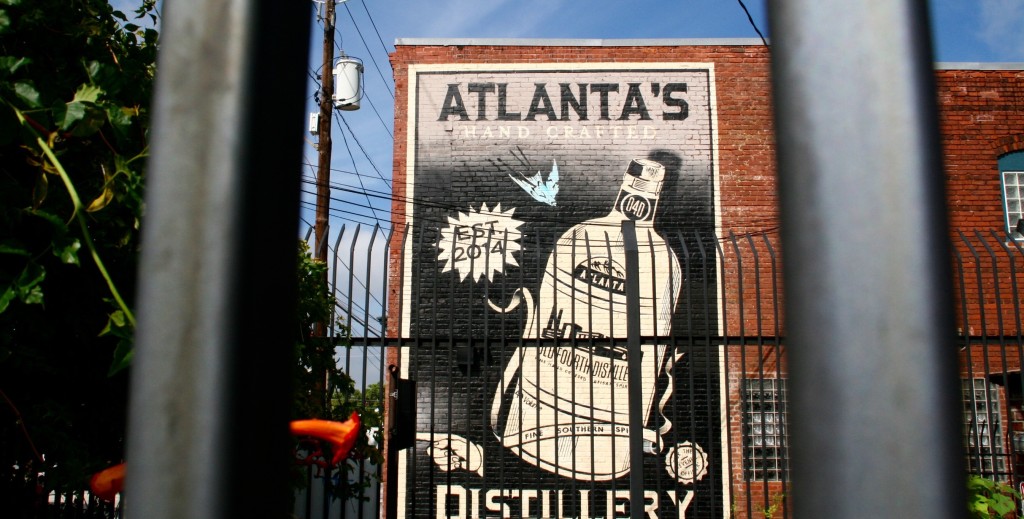
“Atlanta’s distillery.” Right now, it’s true. Old Fourth Distillery IS Atlanta’s distillery – the first legal one we’ve had in more than a hundred years. Back in the day, before Prohibition, Atlanta was by all accounts a booming whiskey town. So booming, in fact, that the hand of Temperance came down hard and strong here, well before Prohibition blanketed the country in a fuzzy whiskey-wanting funk. We went dry. At least by the letter of the law. And no one in Atlanta could conquer the law books and regulatory red tape that pushed us down until Old Fourth Distillery came along. I’m not saying they’re our savior, but now, thanks to O4D, Atlanta may rise once again as a hub of whiskey and spirits production. Rise. Up.
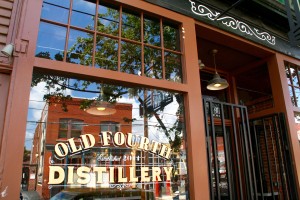 Recently, I headed down to Edgewood Avenue to chat with the O4D gents – Craig Moore, Jeff Moore, and Gabe Pilato. Their micro-distillery sits all shiny behind a welcome room packed with Atlanta distilling memorabilia – the old and the new playing nicely off each other. I knew about the vodka they were distilling down on Edgewood Avenue, the vodka that has been embraced locally by leading bars like Kimball House in Decatur that have been eager for a truly local spirit to serve. And I also knew about the gin they’ve been working up for some time – testing and tasting until they get it just right (that gin should be out before the end of the year, just waiting on the government to catch up and approve the stuff). What I didn’t really get until I visited O4D was the extent to which they have both embraced and literally built upon Atlanta history.
Recently, I headed down to Edgewood Avenue to chat with the O4D gents – Craig Moore, Jeff Moore, and Gabe Pilato. Their micro-distillery sits all shiny behind a welcome room packed with Atlanta distilling memorabilia – the old and the new playing nicely off each other. I knew about the vodka they were distilling down on Edgewood Avenue, the vodka that has been embraced locally by leading bars like Kimball House in Decatur that have been eager for a truly local spirit to serve. And I also knew about the gin they’ve been working up for some time – testing and tasting until they get it just right (that gin should be out before the end of the year, just waiting on the government to catch up and approve the stuff). What I didn’t really get until I visited O4D was the extent to which they have both embraced and literally built upon Atlanta history.
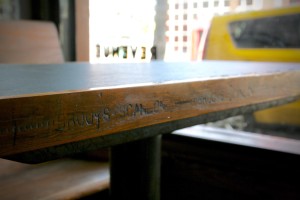 The bead board on the walls, the marble on the counter, the wood in the tables – it’s all repurposed material steeped in Atlanta history, whether from the very same building O4D now sits in (the bead board), or from the gutted John B. Gordon Elementary School down the street that was built in 1909 (the marble). Jeff Moore told me, “We want to protect those kinds of things from being forgotten. It’s part of our story to be related to this area, this city.” Moore went on, and you could tell from his excited intonations that he digs into the minutia when it comes to rooting out the history of his building and the neighborhood:
The bead board on the walls, the marble on the counter, the wood in the tables – it’s all repurposed material steeped in Atlanta history, whether from the very same building O4D now sits in (the bead board), or from the gutted John B. Gordon Elementary School down the street that was built in 1909 (the marble). Jeff Moore told me, “We want to protect those kinds of things from being forgotten. It’s part of our story to be related to this area, this city.” Moore went on, and you could tell from his excited intonations that he digs into the minutia when it comes to rooting out the history of his building and the neighborhood:
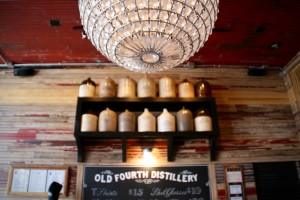 The marble (on the table), that was once dividers in the boys’ stalls in the school, you can see wher the toilet paper holders were. This is actually the same exact marble that was used in the Lincoln Memorial – from Tate, Georgia! We clad the walls with bead board that’s a hundred years old from this building, but also made displays with extra board that went out to liquor stores… and to now have that sitting in stores around Atlanta is very cool. We also used it inside out on the tables – you can see the stamp of Brooks Scanlon Lumber Company… if you’re a railroad guy, you know Brooks Scanlon… and you’d never find that until you pulled it off of our ceilings and looked at the back, and there it is. There are so many interesting stories like that. The seats are old church pews from nearby. It was unbelievably fortuitious how all these things came together – we didn’t have a design firm, we just let the materials we came upon help shape the space.
The marble (on the table), that was once dividers in the boys’ stalls in the school, you can see wher the toilet paper holders were. This is actually the same exact marble that was used in the Lincoln Memorial – from Tate, Georgia! We clad the walls with bead board that’s a hundred years old from this building, but also made displays with extra board that went out to liquor stores… and to now have that sitting in stores around Atlanta is very cool. We also used it inside out on the tables – you can see the stamp of Brooks Scanlon Lumber Company… if you’re a railroad guy, you know Brooks Scanlon… and you’d never find that until you pulled it off of our ceilings and looked at the back, and there it is. There are so many interesting stories like that. The seats are old church pews from nearby. It was unbelievably fortuitious how all these things came together – we didn’t have a design firm, we just let the materials we came upon help shape the space.
More important than the materials that have gone into the O4D space, Moore professed a strong connection to the story of distilling in this city:
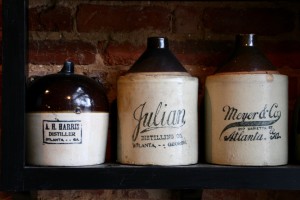 We’ve gained a connection to the lost history of distilling in Atlanta, being the first one in a hundred plus years to produce spirits here. Atlanta could have been a hub of whiskey manufacturing, but the temperance movement came along and wiped that out, so to recall that history – we feel it’s very important. It’s the first thing we talk about on the tours we give here at the distillery, and it’s presented in our bottle design, too. We have a lost history of distilling, but also a lost history of manufacturing things in Atlanta, and it’s really important to us to share that whole idea of purchasing locally produced goods.
We’ve gained a connection to the lost history of distilling in Atlanta, being the first one in a hundred plus years to produce spirits here. Atlanta could have been a hub of whiskey manufacturing, but the temperance movement came along and wiped that out, so to recall that history – we feel it’s very important. It’s the first thing we talk about on the tours we give here at the distillery, and it’s presented in our bottle design, too. We have a lost history of distilling, but also a lost history of manufacturing things in Atlanta, and it’s really important to us to share that whole idea of purchasing locally produced goods.
Moore picked up his well worn copy of the book, Prohibition in Atlanta (if topics like “Rowdyism, Snake Nation, and Slab Town” intrigue you, go get this book), and started thumbing through, calling out interesting facts of Atlanta’s distilling history. The man digs his history. And that history makes its presence felt at O4D, which houses a significant distilling memorabilia collection and has more still under wraps:
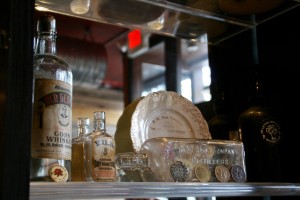 This entire collection (on display) was provided by Butch and Debbie Alley. They are prolific collectors of Atlanta distilling history, and this is the largest display of Atlanta distilling history anywhere. The interesting thing that you find is that we really only know about the most prolific – like R.M. Rose Distilling Company – there were others… L. Cohen; A. H. Harris; Julian; Meyer and Co.; Cox, Hill and Thompson… they were all operating circa 1900, but you don’t find hardly any information on them. As we tell the story in our tours, we’re always asking if anyone knows about any of these, through a family history, or whatever – and it’s a very difficult thing.
This entire collection (on display) was provided by Butch and Debbie Alley. They are prolific collectors of Atlanta distilling history, and this is the largest display of Atlanta distilling history anywhere. The interesting thing that you find is that we really only know about the most prolific – like R.M. Rose Distilling Company – there were others… L. Cohen; A. H. Harris; Julian; Meyer and Co.; Cox, Hill and Thompson… they were all operating circa 1900, but you don’t find hardly any information on them. As we tell the story in our tours, we’re always asking if anyone knows about any of these, through a family history, or whatever – and it’s a very difficult thing.
Indeed, memorabilia from R.M. Rose dominates the collection – both in the numbers of jugs and bottles, as well as in the pile of printed material in protected sleeves that Moore keeps tucked away. Moore explains why Rose has risen to the top when it comes to the historical accounting of distilling in the area:
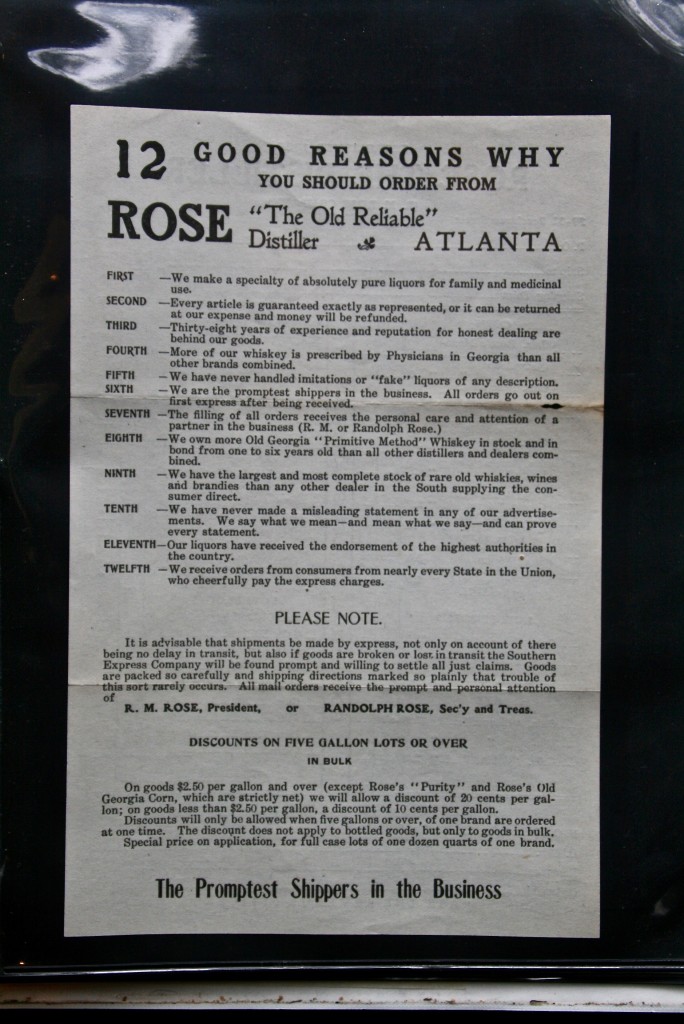 R. M. Rose was a pioneer in making sure that everything that left his facility had his logo on it – most of the others had generic, unmarked jugs. Paper items from the 1800s are hard to come by, but we purchased a collection and are trying to figure out how to properly display it and keep it safe at the same time. We have order sheets from R.M. Rose, and you can see all the things he was offering – not just corn whiskey, but gin, and brandy, and Kentucky whiskey, more. There’s a V.O.S. dry martini (bottled) cocktail. You have to admire their attention to detail (on these papers) – they clearly weren’t moonshiners as we think of it. That’s not how it was – these were businessmen, and they were big parts of their community at the time. “Ask the revenue officer,” (their slogan) was on everything. Rose was a marketing pro, putting his name and face on everything, at a time when the temperance movement was nailing the coffin on his business.
R. M. Rose was a pioneer in making sure that everything that left his facility had his logo on it – most of the others had generic, unmarked jugs. Paper items from the 1800s are hard to come by, but we purchased a collection and are trying to figure out how to properly display it and keep it safe at the same time. We have order sheets from R.M. Rose, and you can see all the things he was offering – not just corn whiskey, but gin, and brandy, and Kentucky whiskey, more. There’s a V.O.S. dry martini (bottled) cocktail. You have to admire their attention to detail (on these papers) – they clearly weren’t moonshiners as we think of it. That’s not how it was – these were businessmen, and they were big parts of their community at the time. “Ask the revenue officer,” (their slogan) was on everything. Rose was a marketing pro, putting his name and face on everything, at a time when the temperance movement was nailing the coffin on his business.
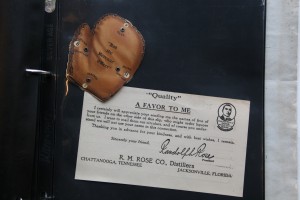 Their manufacturing was in Vinings, with offices and a retail store on Broad Street, and his big warehouse was on Auburn Ave. Around 1907, R.M. Rose was forced out of Atlanta, and moved first to Jacksonville, Florida, and later to Chattanooga. (At that time) it was not illegal (for consumers) to purchase spirits from Atlanta, so they would send R.M. Rose a money order and Rose would put a jug on a train for them (the consumer) to pick up. And 1907 to 1917 was their most prolific time period to advertise to make sure Atlanta knew he wasn’t completely gone. Right around 1917, the kibosh was put on that completely and R.M. Rose soon filed for bankruptcy.
Their manufacturing was in Vinings, with offices and a retail store on Broad Street, and his big warehouse was on Auburn Ave. Around 1907, R.M. Rose was forced out of Atlanta, and moved first to Jacksonville, Florida, and later to Chattanooga. (At that time) it was not illegal (for consumers) to purchase spirits from Atlanta, so they would send R.M. Rose a money order and Rose would put a jug on a train for them (the consumer) to pick up. And 1907 to 1917 was their most prolific time period to advertise to make sure Atlanta knew he wasn’t completely gone. Right around 1917, the kibosh was put on that completely and R.M. Rose soon filed for bankruptcy.
The R.M. Rose marketing materials and order sheets from that period before 1917 are simply fascinating, both from an historical booze perspective as well as a marketing perspective. Here are some great tidbits from the marketing piece pictured above – “12 GOOD REASONS WHY YOU SHOULD ORDER FROM ROSE”…
#4: More of our whiskey is prescribed by Physicians in Georgia than all other brands combined. (It’s good for you!)
#8: We own more Old Georgia ‘Primitive Method’ Whiskey in stock and in bond from one to six years old than any other dealer in the South. (Even back then, the good old days had their charms.)
#9: We have the largest and most complete stock of rare old whiskies, wines and brandies than any other dealer in the South. (And even back then, whiskey geeks chased rare stuff.)
#10: We have never made a misleading statement in any of our advertisements. We say what we mean – and mean what we say – and can prove every statement. (Truth in advertising – and labeling – was worth mentioning, back then as today.)
#12: We receive orders from consumers from nearly every State in the Union, whocheefully pay the express charges. (These guys were not just for locals – they apparently played on a national stage.)
And based on an order sheet from that period between 1907 and 1917, the variety of goods 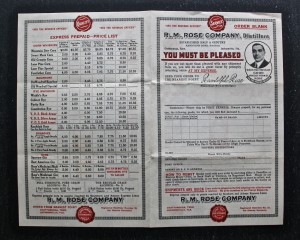 that Randolph Rose offered as a retailer was truly impressive, though they clearly weren’t distilling the majority of it. Indeed, as happens today, it’s a bit hard to figure out what exactly was produced by R.M. Rose (who does call themselves “distillers”) vs. sourced from elsewhere. In the category of things clearly sourced, there’s California port and sherry, a Spanish sherry, a dessert wine of unknown provenance. Then, less clear, there’s a Lone Pine brand corn whiskey (“old-time corn whiskey at a reasonable price, with the flavor of real Georgia Corn”), and Old Woodruff brand bourbon from Kentucky, neither of
that Randolph Rose offered as a retailer was truly impressive, though they clearly weren’t distilling the majority of it. Indeed, as happens today, it’s a bit hard to figure out what exactly was produced by R.M. Rose (who does call themselves “distillers”) vs. sourced from elsewhere. In the category of things clearly sourced, there’s California port and sherry, a Spanish sherry, a dessert wine of unknown provenance. Then, less clear, there’s a Lone Pine brand corn whiskey (“old-time corn whiskey at a reasonable price, with the flavor of real Georgia Corn”), and Old Woodruff brand bourbon from Kentucky, neither of 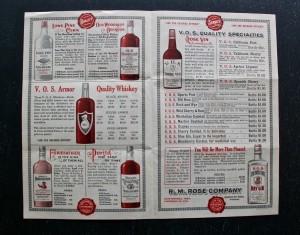 which seem to be distilled by Rose. There’s Rose’s Purity – “for fifty years… the South’s leading medicinal and family whiskey… a perfect blend of fine old whiskies” – that seems to be a custom blend for Rose. Or Sir Randolph Dry Gin – “distilled by my own formula… superior to the imported.” There are actually eight different rye whiskeys, one of which is Randolph Rose Bottled in Bond, which seems the most likely to have been distilled by Rose themselves. I’d love to be able to go back in time and sort out the distinctions between each of these, the most expensive of which ran for $6 for 4 quarts – roughly the equivalent of a $30 750ml bottle of rye today, adjusted for inflation. The cheapest spirit was, not surprisingly, the “mountain dew corn whiskey,” which ran for roughly the equivalent of $13.25 today.
which seem to be distilled by Rose. There’s Rose’s Purity – “for fifty years… the South’s leading medicinal and family whiskey… a perfect blend of fine old whiskies” – that seems to be a custom blend for Rose. Or Sir Randolph Dry Gin – “distilled by my own formula… superior to the imported.” There are actually eight different rye whiskeys, one of which is Randolph Rose Bottled in Bond, which seems the most likely to have been distilled by Rose themselves. I’d love to be able to go back in time and sort out the distinctions between each of these, the most expensive of which ran for $6 for 4 quarts – roughly the equivalent of a $30 750ml bottle of rye today, adjusted for inflation. The cheapest spirit was, not surprisingly, the “mountain dew corn whiskey,” which ran for roughly the equivalent of $13.25 today.
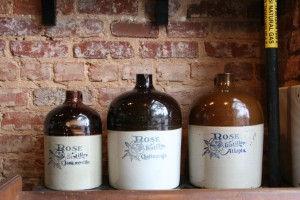 Most intriguing are the bottled cocktails – Rock and Rye (“very fine in warding off colds”), Wild Cherry Cordial and Rum (“fine in case of colds or grippe”), Manhattan Cocktail (“made after my own recipe, and superior to the best served in high class clubs”), or Martini Cocktail (“an especially good article made with Sir Randolph Dry Gin”). All $1 each (equivalent to $24 today). What I wouldn’t do for a bottle of each of those to see how the folks were drinking in 1907, and what their benchmarks were when it came to cocktails.
Most intriguing are the bottled cocktails – Rock and Rye (“very fine in warding off colds”), Wild Cherry Cordial and Rum (“fine in case of colds or grippe”), Manhattan Cocktail (“made after my own recipe, and superior to the best served in high class clubs”), or Martini Cocktail (“an especially good article made with Sir Randolph Dry Gin”). All $1 each (equivalent to $24 today). What I wouldn’t do for a bottle of each of those to see how the folks were drinking in 1907, and what their benchmarks were when it came to cocktails.
In any case, the history of Atlanta-related distilling and booze marketing is fascinating, and the present of Atlanta distilling has the opportunity to recapture some of that long lost intrigue. O4D is paving the way, from their very prominent focus on the city’s rich history, to the fact that we once again have a legal still operating in the city. When I was meeting with Jeff, Craig, and Gabe, a call came in and they let me know they had to rush out – 45 barrels of whiskey were about to be delivered, ready to be racked into O4D’s warehouse to sit for at least four years. Jeff wrapped up our discussion by bridging the divide between the Prohibition era and Atlanta’s future as a homebase for distillers:
We’ve worked to challenge some of these Prohibition-era laws that are still on the books today. There was no one asking before. And I don’t want to be the only distiller here (in Atlanta). American Spirit Whiskey recently broke ground (installing their stills in Atlanta), and we get calls almost every day from other folks interested in starting something. Atlanta deserves to have choices of locally made products. We want this to pick up steam.
Indeed, we do. Get your butt down to O4D to take a tour, soak in the history, and sample the Atlanta-made vodka and (soon, soon) gin. What are you waiting for? Was the past hundred plus years not long enough?
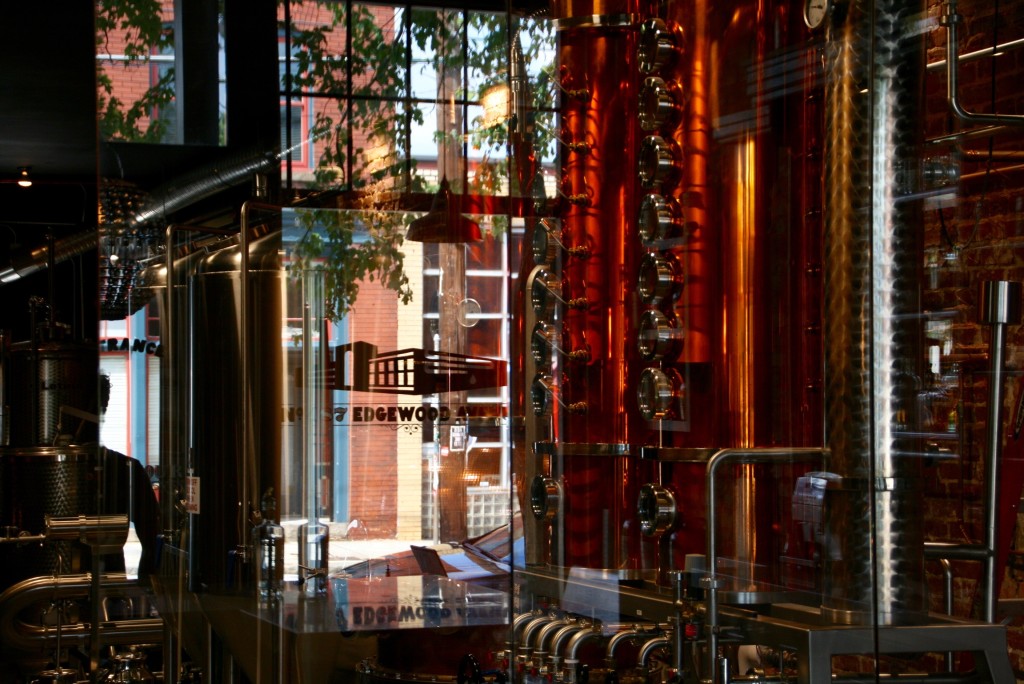
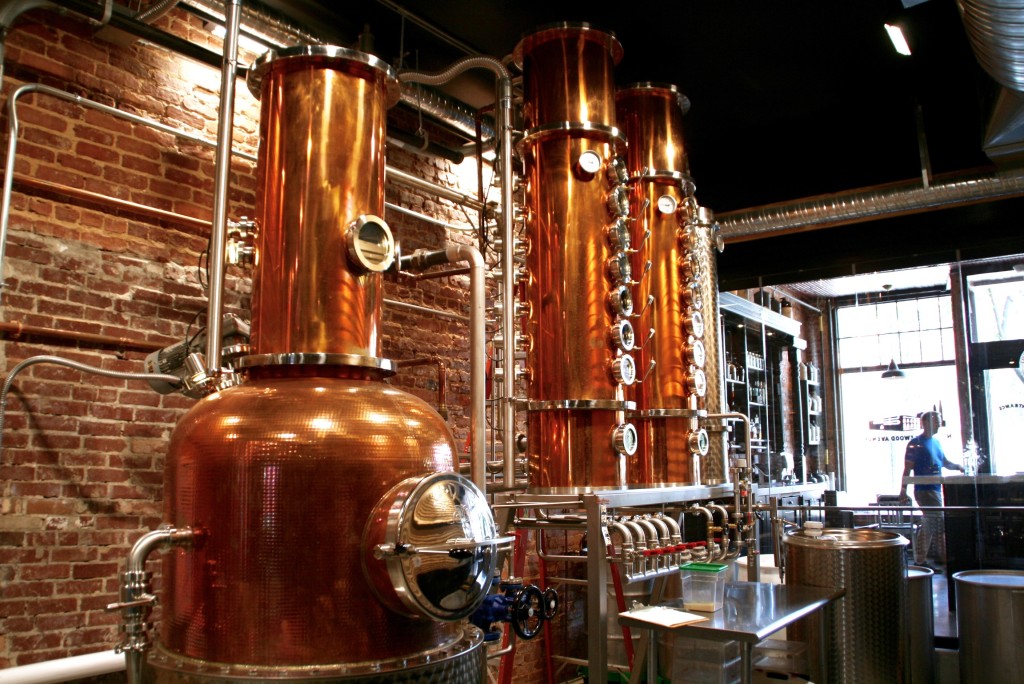
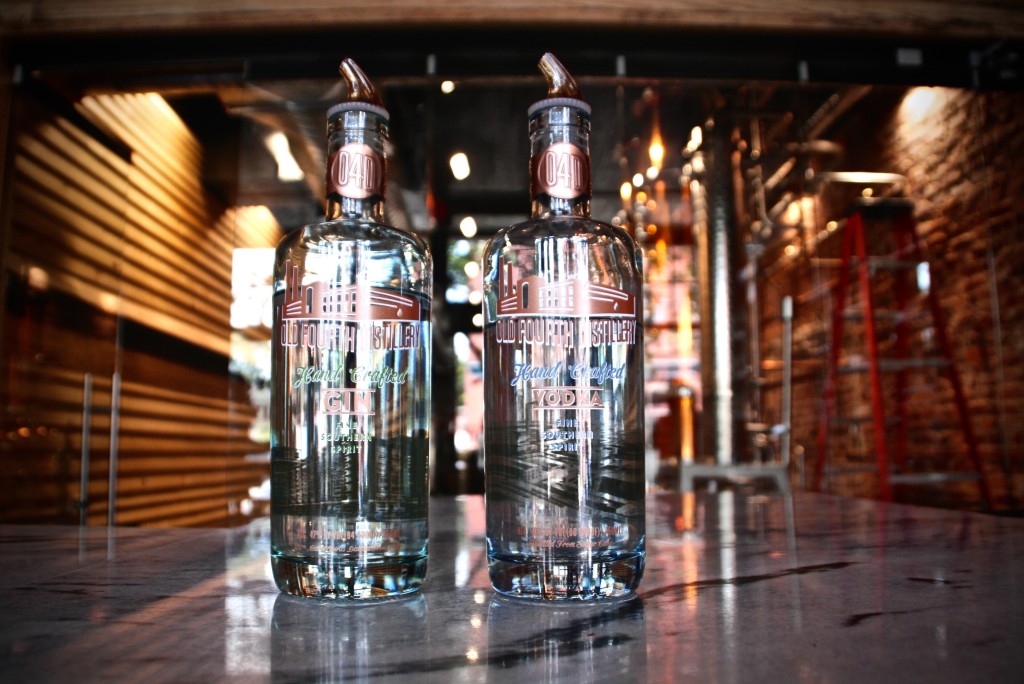
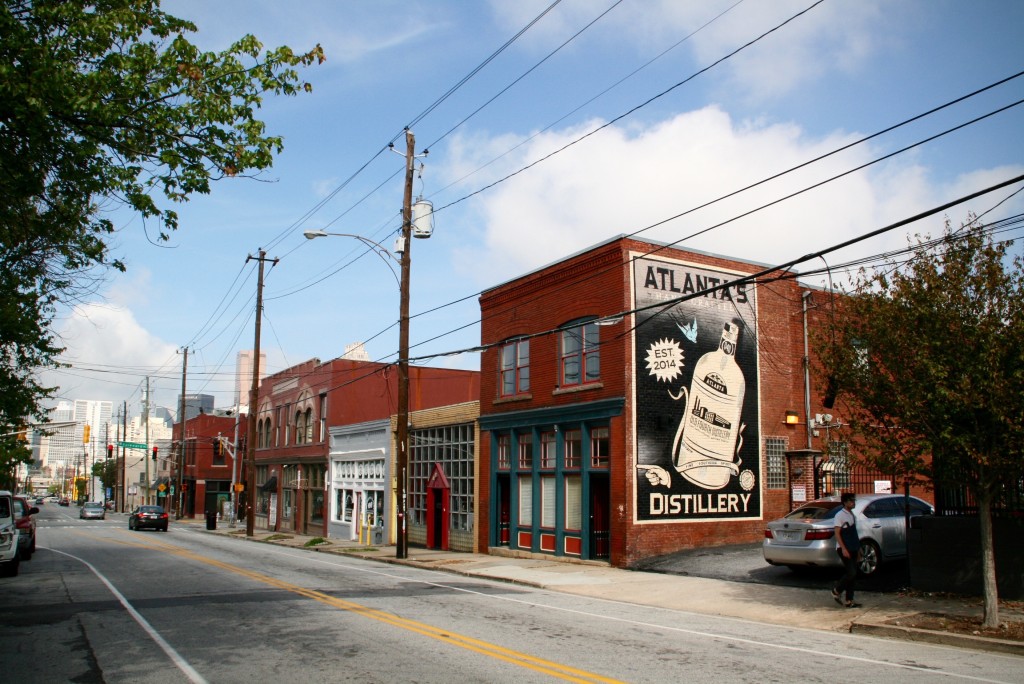


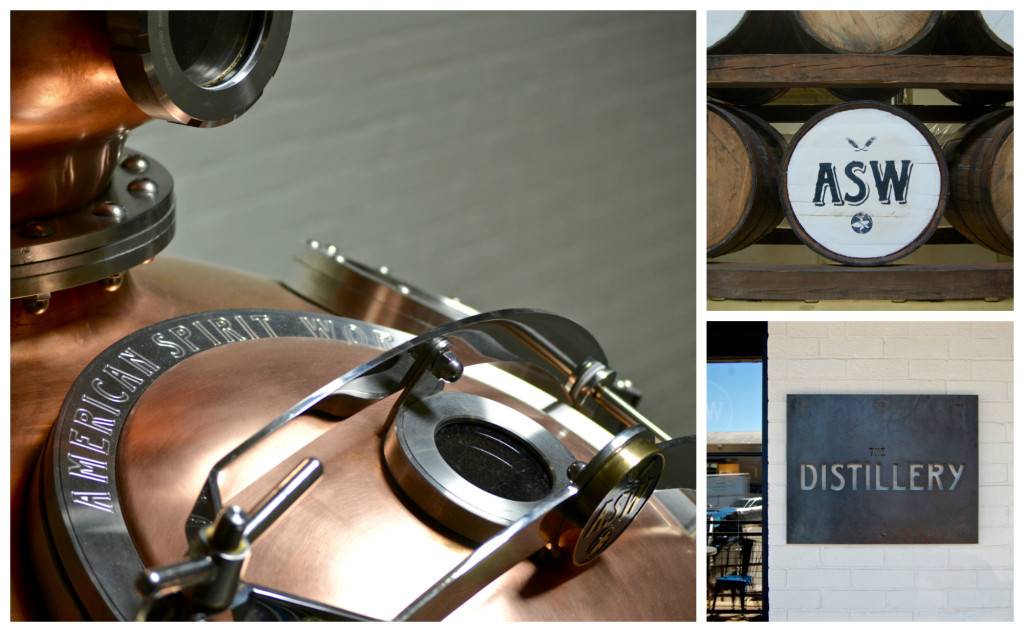
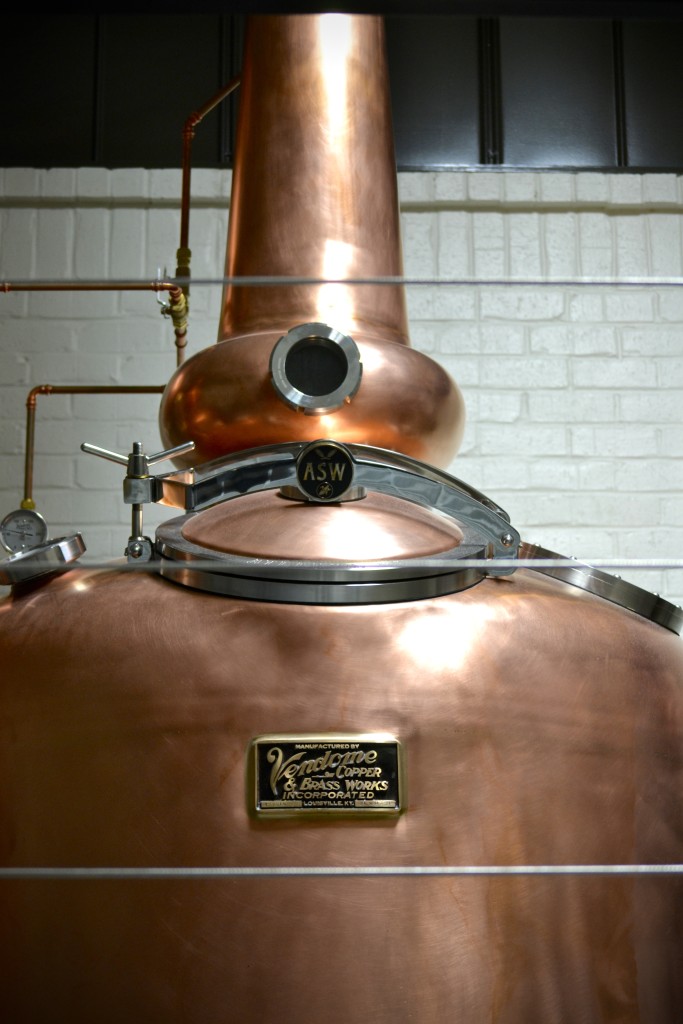
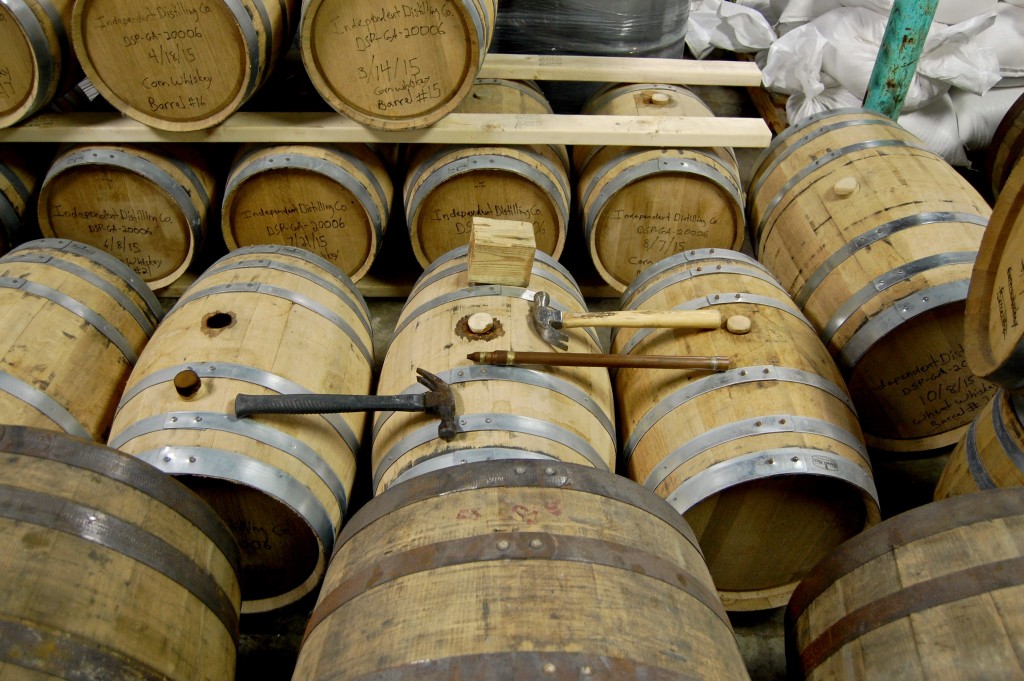
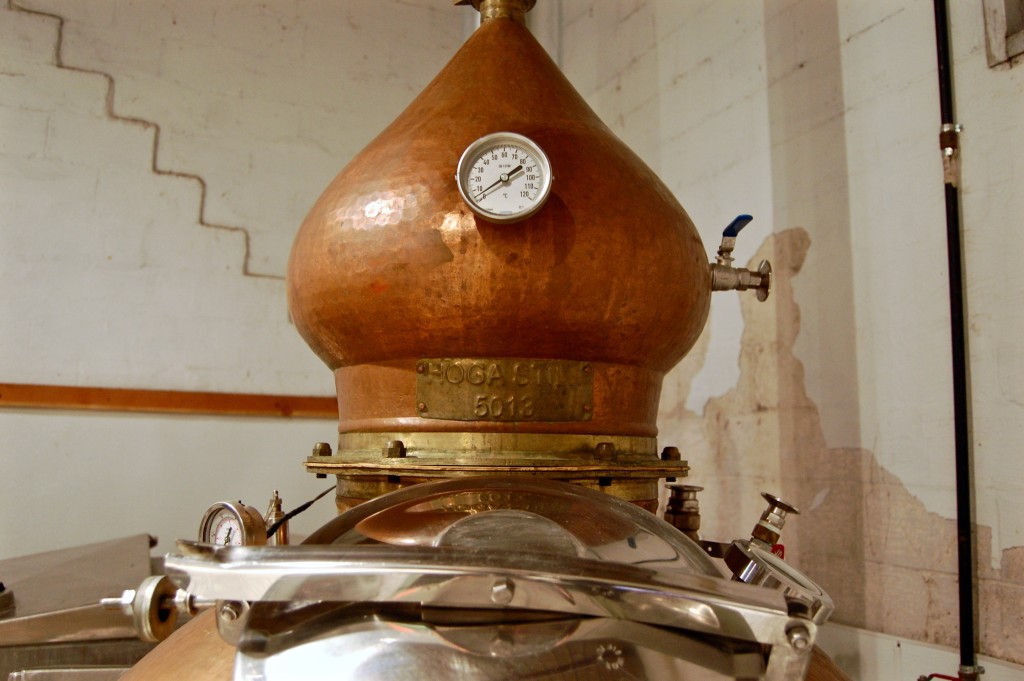
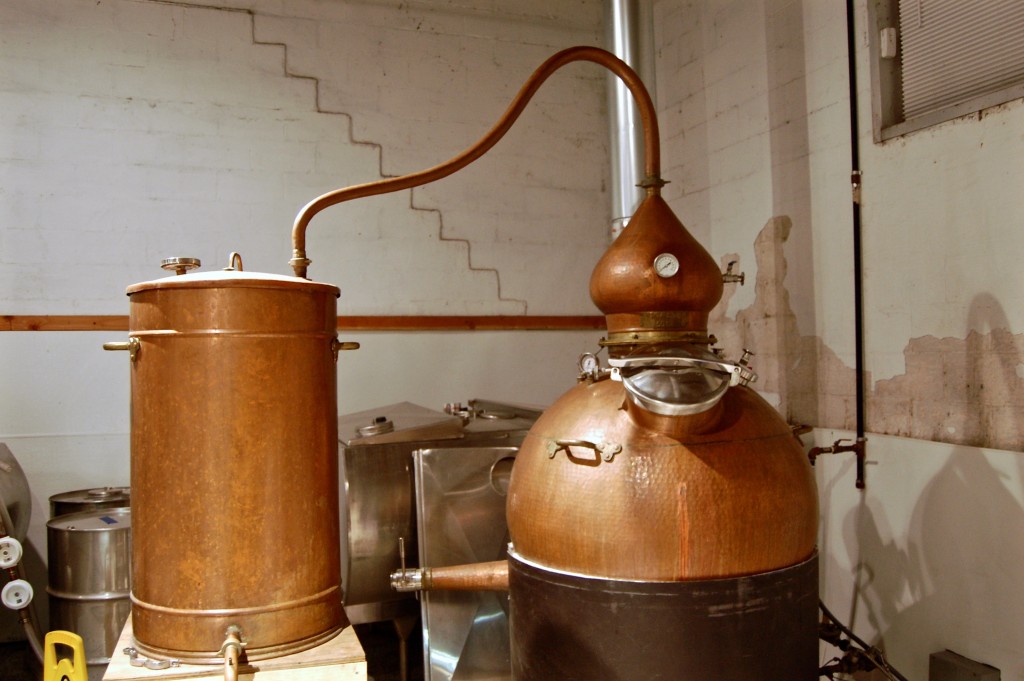
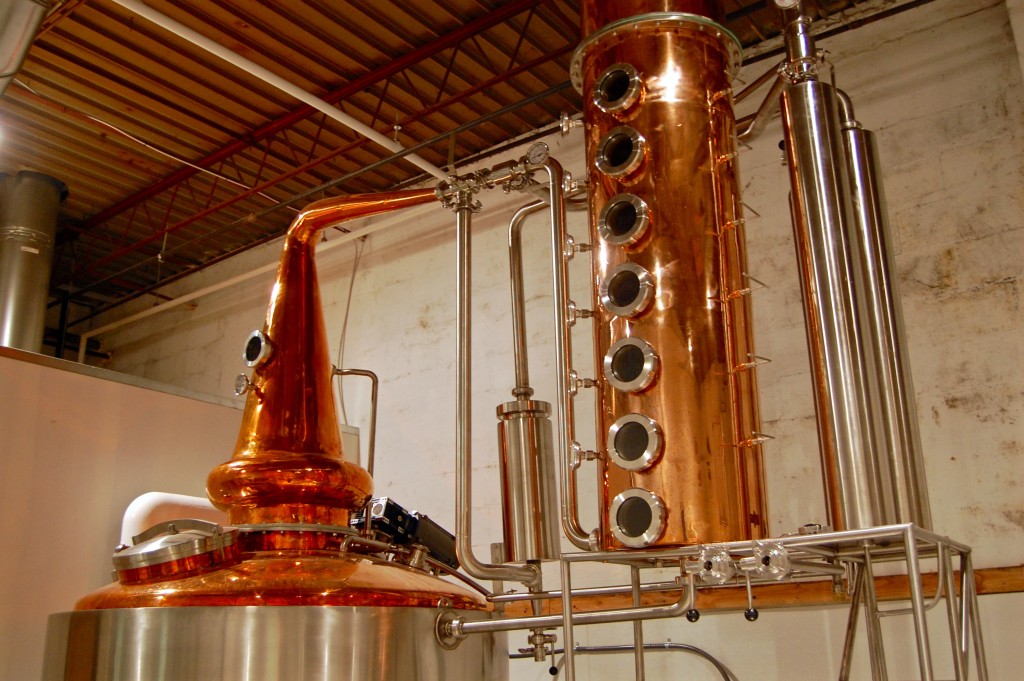
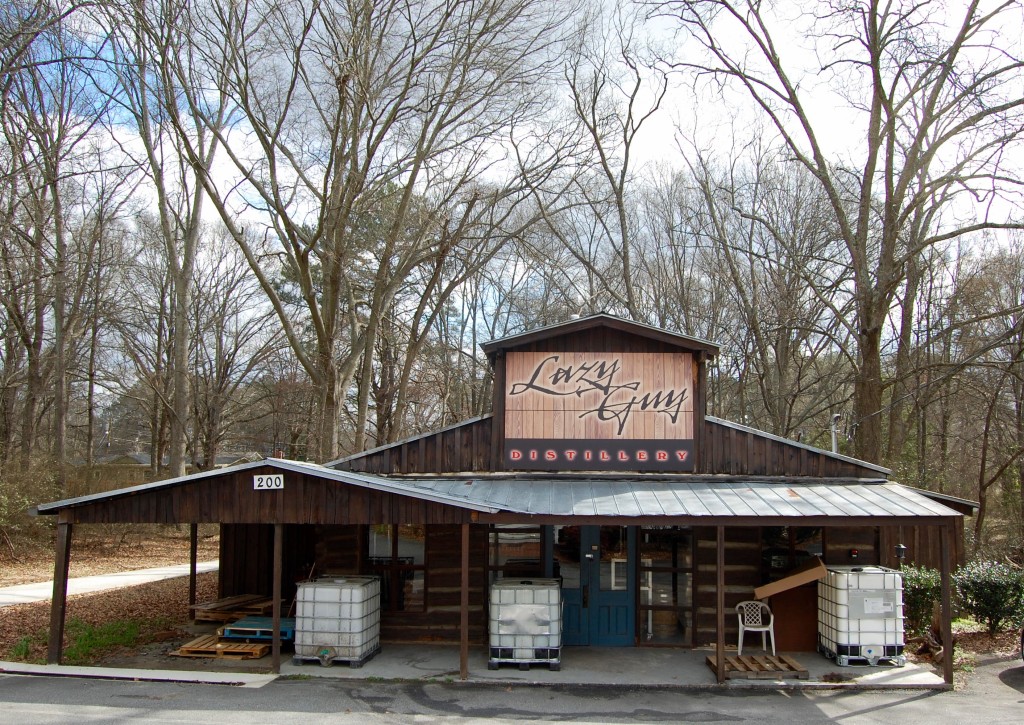
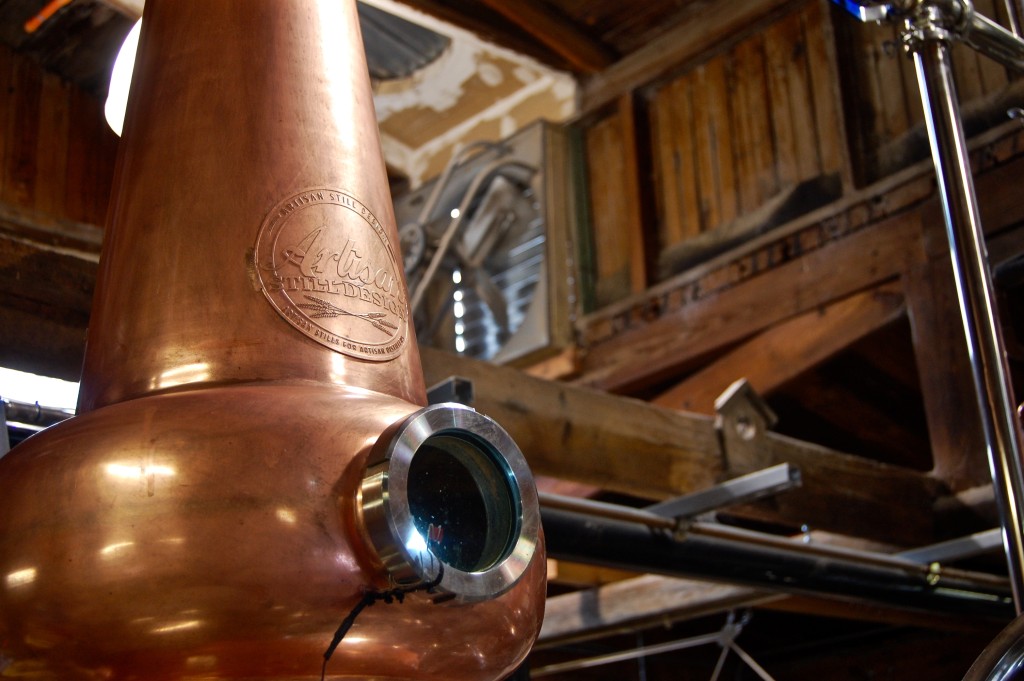
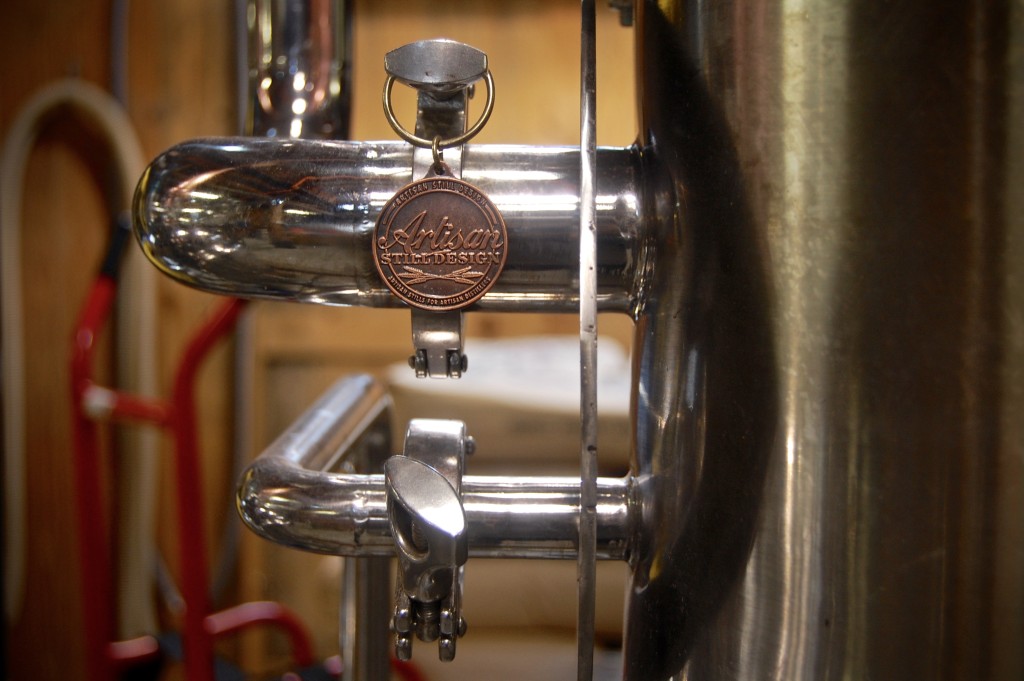
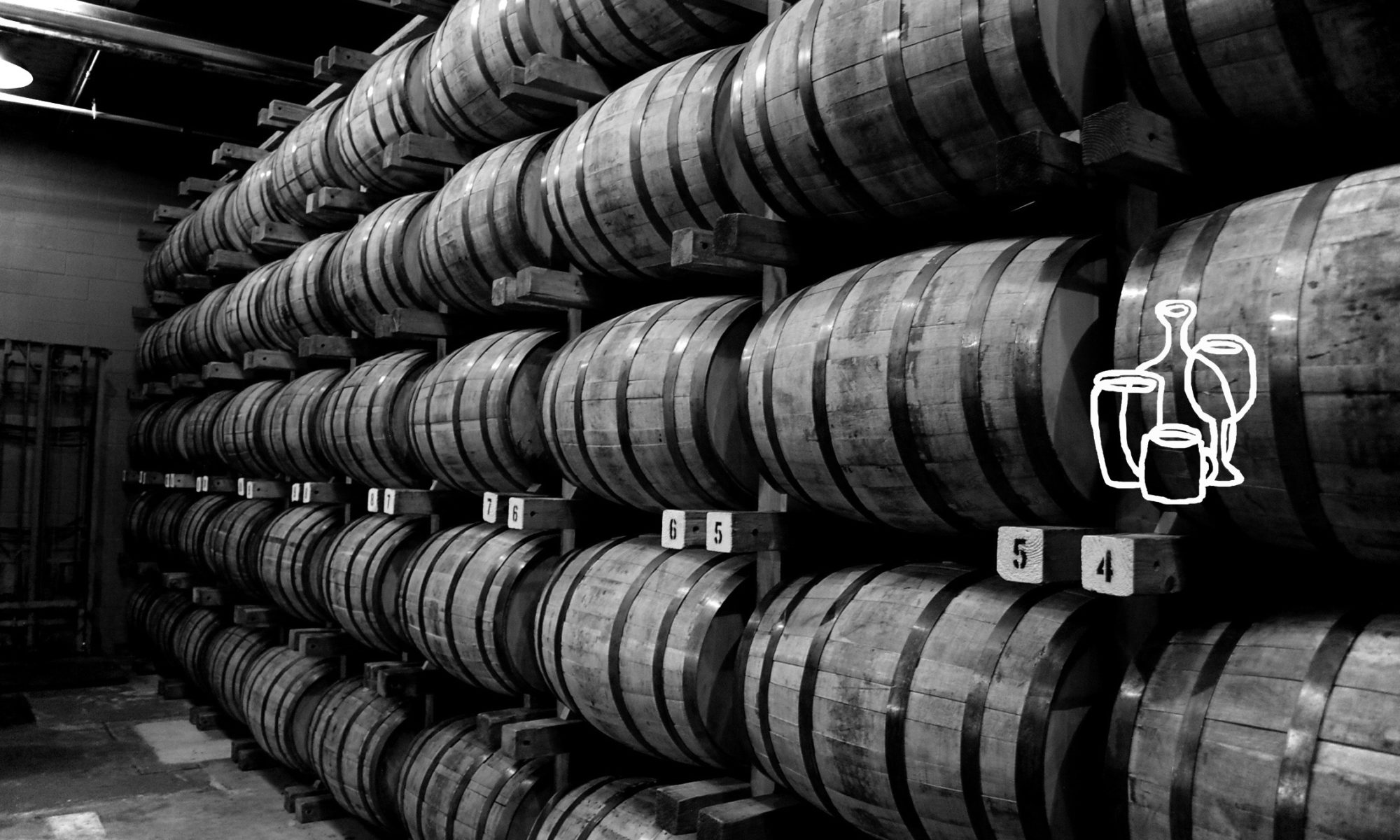
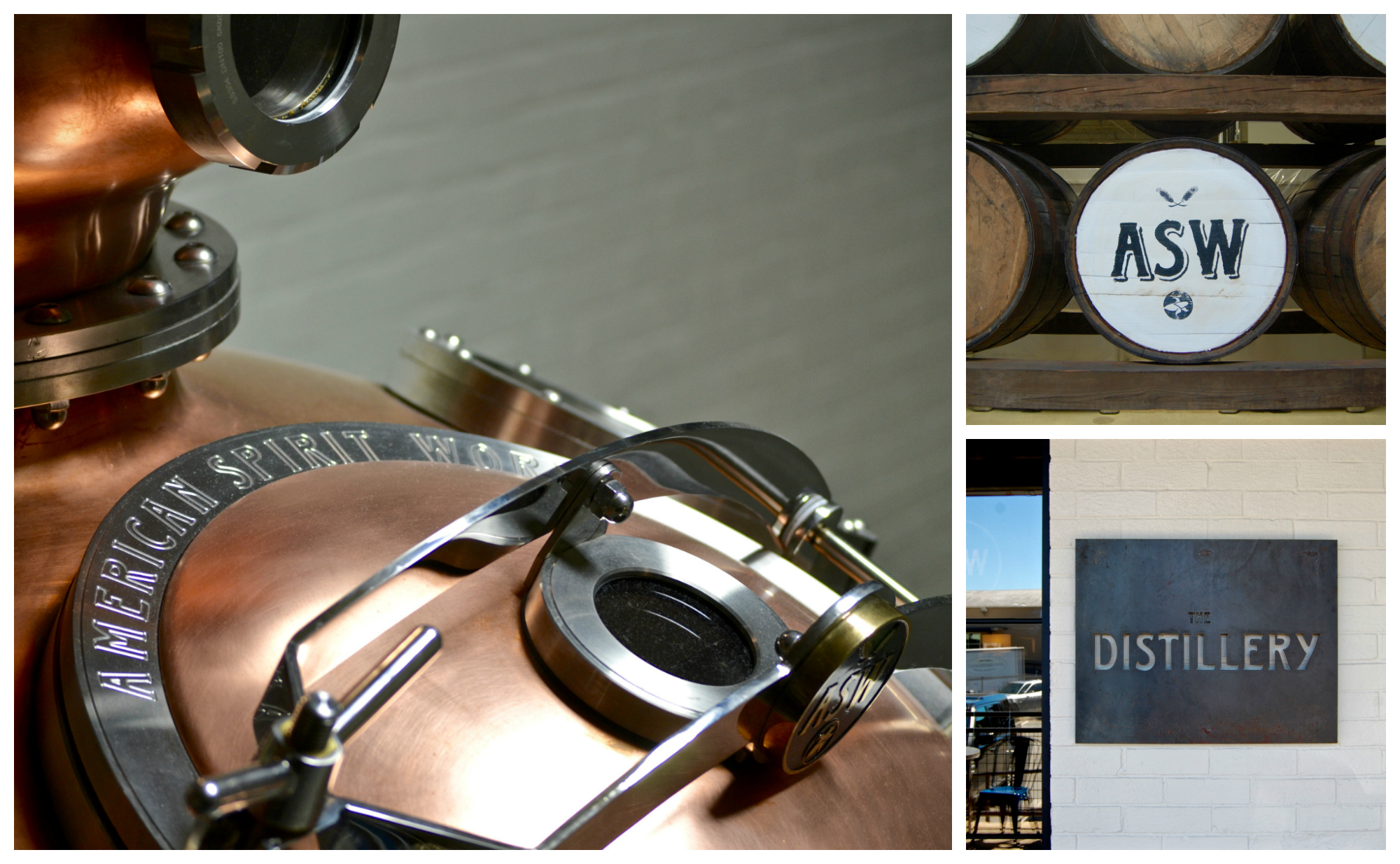



 The bead board on the walls, the marble on the counter, the wood in the tables – it’s all repurposed material steeped in Atlanta history, whether from the very same building O4D now sits in (the bead board), or from the gutted John B. Gordon Elementary School down the street that was built in 1909 (the marble). Jeff Moore told me, “We want to protect those kinds of things from being forgotten. It’s part of our story to be related to this area, this city.” Moore went on, and you could tell from his excited intonations that he digs into the minutia when it comes to rooting out the history of his building and the neighborhood:
The bead board on the walls, the marble on the counter, the wood in the tables – it’s all repurposed material steeped in Atlanta history, whether from the very same building O4D now sits in (the bead board), or from the gutted John B. Gordon Elementary School down the street that was built in 1909 (the marble). Jeff Moore told me, “We want to protect those kinds of things from being forgotten. It’s part of our story to be related to this area, this city.” Moore went on, and you could tell from his excited intonations that he digs into the minutia when it comes to rooting out the history of his building and the neighborhood: The marble (on the table), that was once dividers in the boys’ stalls in the school, you can see wher the toilet paper holders were. This is actually the same exact marble that was used in the Lincoln Memorial – from Tate, Georgia! We clad the walls with bead board that’s a hundred years old from this building, but also made displays with extra board that went out to liquor stores… and to now have that sitting in stores around Atlanta is very cool. We also used it inside out on the tables – you can see the stamp of Brooks Scanlon Lumber Company… if you’re a railroad guy, you know Brooks Scanlon… and you’d never find that until you pulled it off of our ceilings and looked at the back, and there it is. There are so many interesting stories like that. The seats are old church pews from nearby. It was unbelievably fortuitious how all these things came together – we didn’t have a design firm, we just let the materials we came upon help shape the space.
The marble (on the table), that was once dividers in the boys’ stalls in the school, you can see wher the toilet paper holders were. This is actually the same exact marble that was used in the Lincoln Memorial – from Tate, Georgia! We clad the walls with bead board that’s a hundred years old from this building, but also made displays with extra board that went out to liquor stores… and to now have that sitting in stores around Atlanta is very cool. We also used it inside out on the tables – you can see the stamp of Brooks Scanlon Lumber Company… if you’re a railroad guy, you know Brooks Scanlon… and you’d never find that until you pulled it off of our ceilings and looked at the back, and there it is. There are so many interesting stories like that. The seats are old church pews from nearby. It was unbelievably fortuitious how all these things came together – we didn’t have a design firm, we just let the materials we came upon help shape the space.


 Their manufacturing was in Vinings, with offices and a retail store on Broad Street, and his big warehouse was on Auburn Ave. Around 1907, R.M. Rose was forced out of Atlanta, and moved first to Jacksonville, Florida, and later to Chattanooga. (At that time) it was not illegal (for consumers) to purchase spirits from Atlanta, so they would send R.M. Rose a money order and Rose would put a jug on a train for them (the consumer) to pick up. And 1907 to 1917 was their most prolific time period to advertise to make sure Atlanta knew he wasn’t completely gone. Right around 1917, the kibosh was put on that completely and R.M. Rose soon filed for bankruptcy.
Their manufacturing was in Vinings, with offices and a retail store on Broad Street, and his big warehouse was on Auburn Ave. Around 1907, R.M. Rose was forced out of Atlanta, and moved first to Jacksonville, Florida, and later to Chattanooga. (At that time) it was not illegal (for consumers) to purchase spirits from Atlanta, so they would send R.M. Rose a money order and Rose would put a jug on a train for them (the consumer) to pick up. And 1907 to 1917 was their most prolific time period to advertise to make sure Atlanta knew he wasn’t completely gone. Right around 1917, the kibosh was put on that completely and R.M. Rose soon filed for bankruptcy.






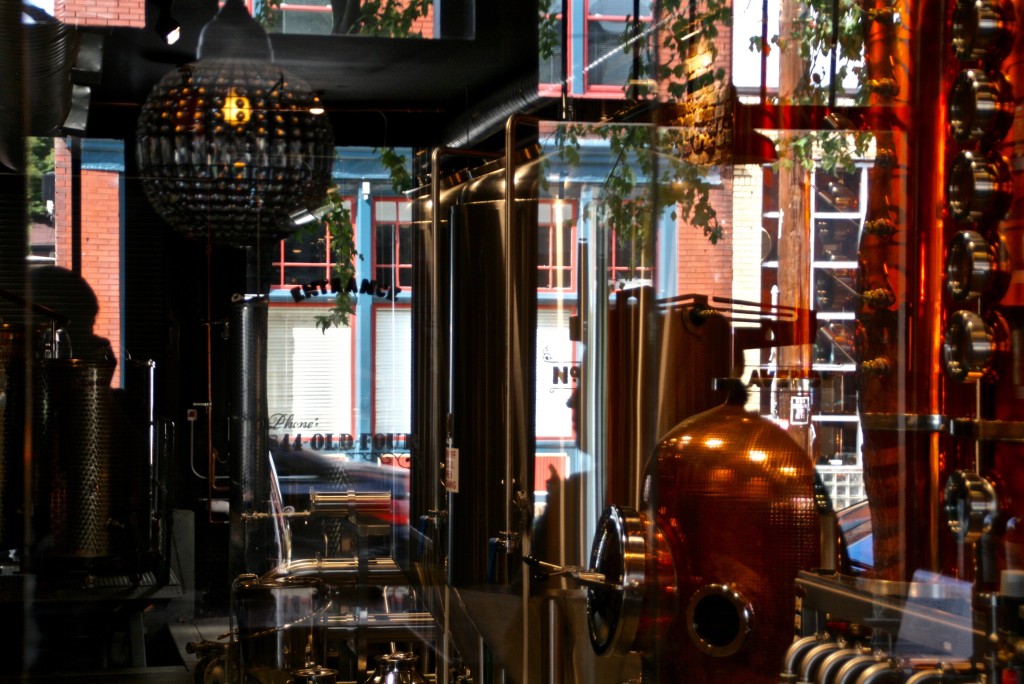

 For sons and daughters of the South, there are few memories of youth as fine as that of discovering a good honeysuckle patch and having an older sibling or friend or parent show you the precious prize that rests within each little flower. You mean there’s more to that messy bush of tiny flowers than just an intoxicating aroma? Then you try one – plucking a honeysuckle flower off the vine, carefully clipping off the end and pulling the stamen on through the flower, hoping and praying that your bit of effort results in a big blob of honeysuckle nectar, then seeing that drop emerge on the end of the string and dipping it onto your tongue. Ahhh, a too tiny touch of heaven. You can see why I might be excited at the prospect of a good honeysuckle flavored spirit – the mystical honeysuckle is engrained in my memories.
For sons and daughters of the South, there are few memories of youth as fine as that of discovering a good honeysuckle patch and having an older sibling or friend or parent show you the precious prize that rests within each little flower. You mean there’s more to that messy bush of tiny flowers than just an intoxicating aroma? Then you try one – plucking a honeysuckle flower off the vine, carefully clipping off the end and pulling the stamen on through the flower, hoping and praying that your bit of effort results in a big blob of honeysuckle nectar, then seeing that drop emerge on the end of the string and dipping it onto your tongue. Ahhh, a too tiny touch of heaven. You can see why I might be excited at the prospect of a good honeysuckle flavored spirit – the mystical honeysuckle is engrained in my memories. Cathead Honeysuckle Flavored Vodka
Cathead Honeysuckle Flavored Vodka The fact that Cathead’s regular vodka is so nice makes this all the more confounding. And the Honeysuckle is just 70 proof? Cathead was on to something when they lowered the alcohol in the Honeysuckle, but they didn’t go far enough if they want anyone to enjoy this out of the bottle. And maybe that’s the point – this cries out for mixing, but it didn’t have to be so.
The fact that Cathead’s regular vodka is so nice makes this all the more confounding. And the Honeysuckle is just 70 proof? Cathead was on to something when they lowered the alcohol in the Honeysuckle, but they didn’t go far enough if they want anyone to enjoy this out of the bottle. And maybe that’s the point – this cries out for mixing, but it didn’t have to be so.












